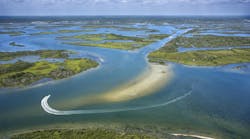About the author: Caitlin Cunningham is managing editor of Storm Water Solutions. Cunningham can be reached at 847.391.1025 or by e-mail at [email protected].
The most recently released Natural Resources Defense Council (NRDC) Testing the Waters survey tallied more than 25,000 closure and swimming advisory days at U.S. ocean, bay and Great Lakes beaches in 2006—a record high for the 17-years-running survey. Storm water runoff carries many problem pollutants into coastal waters and thus will be a major factor in helping reduce health risk-related beach closings and advisories. With summer in full swing, Storm Water Solutions’ Managing Editor Caitlin Cunningham turned to Nancy Stoner, director of NRDC’s Clean Water Project, for the most up-to-date beach water quality information and input.
Caitlin Cunningham: What water conditions typically necessitate a beach closing or swimming advisory?
Nancy Stoner: Beaches are closed or advisories issued because there is human or animal waste in the water. Water is tested for bacteria that you find in the digestive tracts of humans and animals. When found in the water at a sufficiently high level, that means there is a greater likelihood that swimmers will get sick.
Cunningham: What role does storm water play in our nation’s increasingly severe beach pollution problem?
Stoner: Storm water is the largest known cause of beach closings and advisories every year. The largest cause is actually unknown, which is a problem that we’re trying to address by getting beaches to do source tracking, sanitary surveys and other means of finding the sources of beach water pollution so that they can be cleaned up. Of the known causes, though, storm water is always No. 1.
What happens is that when it rains, the rain picks up everything on the surface of the Earth and carries it into the waterways. In a natural environment, this isn’t a problem—the soil, trees and vegetation absorb storm water and filter out the pollution. But once we pave over the natural environment and then also add trash, pet waste, fertilizer, pesticides, oil—all those pollutants we put on the surface of the Earth—it is all carried into waterways when it rains.
Cunningham: What steps is NRDC taking to keep beaches safe and open?
Stoner: One thing is supporting the Beach Protection Act, which is currently moving through Congress. What the Beach Protection Act would do is provide funding to expand beach water monitoring and public notification programs to also include source tracking and money for remediation. What that means is that beach water managers will not only be able to find problems but also be able to fix problems.
We’re also working to address the sources of beach water pollution. NRDC has been working to address storm water in particular for more than two decades. We were involved in the 1987 Clean Water Act amendments that clarified that storm water pollution is covered by the permitting requirements of the law, and we’ve been working ever since then to ensure that the sources of storm water pollution are being adequately controlled. We particularly like techniques called “green” infrastructure or low-impact development, which involve using soil and vegetation to trap and filter out pollution, because they provide multiple environmental benefits and are often less expensive.
Cunningham: What can storm water professionals do to help alleviate beach pollution loads?
Stoner: There’s a lot of things that storm water professionals can do. One is to make sure that storm drains are not discharging onto beaches. Also, maintaining coastal dunes and other kinds of vegetation that filter out the storm water and, as I mentioned earlier, using low-impact development to offload storm water from the system.
Nancy Stoner can be reached at 202.289.2394. For more information, visit www.nrdc.org.
Download: Here

